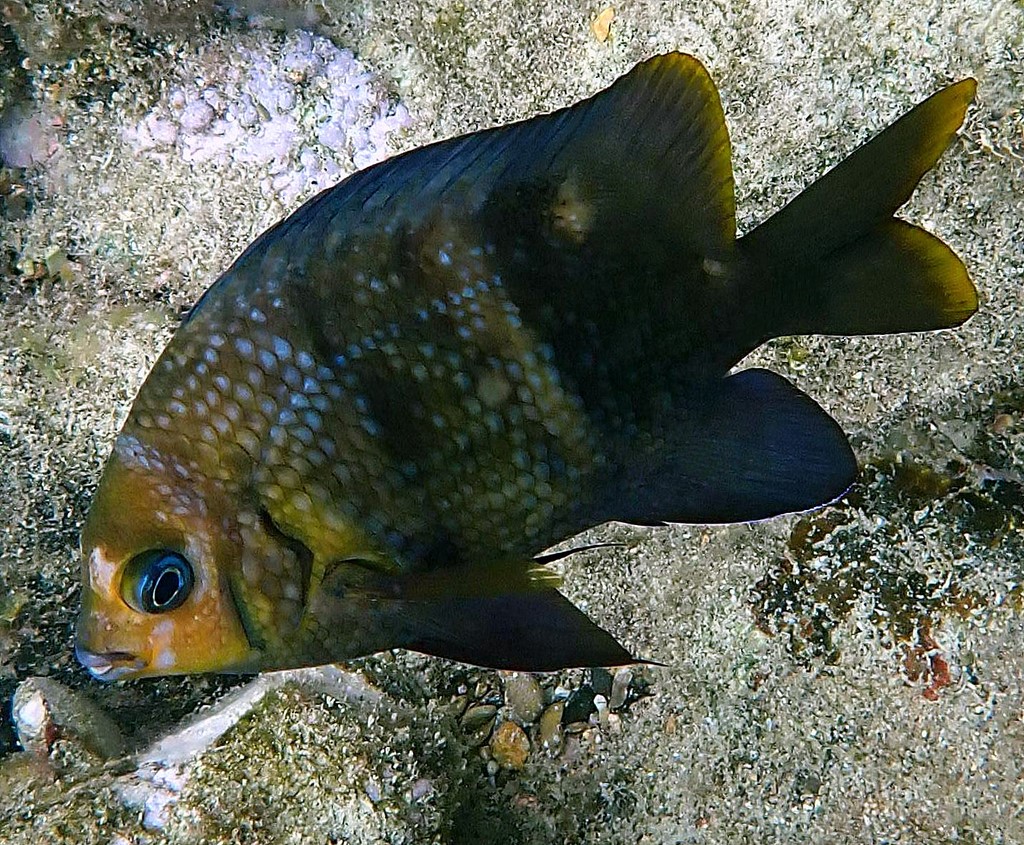PARMA POLYLEPIS - (GUNTHER, 1862)
Picture courtesy of: Claire Goiran
Actinopterygii (Gigaclass) > Actinopteri (Class) > Teleostei (Subclass) > Blenniiformes (Order) > Pomacentridae (Family) > Microspathodontinae (Subfamily) > Parma (Genus)
Banded scalyfin, Banded parma,
Description
Dorsal spines (total): 13; Dorsal soft rays (total): 17-19; Anal spines: 2; Anal soft rays: 13-14; Pectoral fin rays: 20-22; Lateral line scales (tubed): 26-33; Gill rakers: 7-11 + 1 + 9-11 (total: 17-23); Teeth in jaws: 48-56. Body depth: 1.6-1.7 in SL; Head length: 3.2-3.4 in standard length; Snout: 2.5-2.7, eye: 3.2-4.1, interorbital: 2.3-2.8 in HL; Caudal peduncle depth: 1.7-1.9 in HL, length of caudal peduncle: 3.3-4.0 in HL. Max. length: 22.0 cm TL. Depth range: 1 - 40 m.
Color
Juveniles (about 25-80 mm SL) with two prominent whitish bars on sides, the first from base of anterior dorsal-fin spines to behind and below the pectoral-fin base; The second from base of 9th-11th dorsal-fin spines to the anal-fin origin. Tail base, breast and lower part of head reddish-brown; A dark brown streak on the gill cover; An indistinct pale band extending from nape to lower edge of gill cover; Spinous dorsal fin brown to dusky, except where interrupted by extensions of pale bars on sides. Soft dorsal fin dark brown basally, translucent distally, with a pale-rimmed black ocellus between the 10th dorsal-fin spine and 2nd or 3rd soft ray; Ocellus rimmed with an iridescent pale blue in juveniles. Anal and pelvic fins mostly dark brown to blackish; Caudal fin dusky to translucent; Pectoral fins pale with a dark spot on upper portion of fin base and frequently on lower corner. Juveniles often have yellowish fins. The ocellus and pale bars gradually fade with growth. The ocellus usually disappears before individuals reach about 100 mm SL, and the bars are usually lost between about 110-140 mm SL. The ocellus is sometimes replaced by a whitish blotch in subadults. At Lord Howe Island, the upper part of the head is usually yellowish in adults. In northern New South Wales mature adults may have a pale band behind the head.
Etymology
Parma: from Latin, parma, -ae = a little shield. Referring to smooth opercles compared to serrated or denticulated opercles of Amphiprion, Dascyllus, Lepidozygus and Premnas.
polylepis: from Latin, poly = many + from Latin, lepis = scale. Referring to smaller (and therefore more numerous) scales compared to species in Glyphisodon (=Abudefduf).
Original description: Parma polylepis Günther, 1862 - Type locality: Norfolk Island.
Distribution
Southwestern Pacific: Capricorn Group (Queensland) south to Bass Point (New South Wales, Australia), Lord Howe Island, Norfolk Island, New Caledonia, and northern New Zealand.
Biology
Adults occur in lagoons and outer rocky reefs. Feed mostly on algae. Oviparous, distinct pairing during breeding. Eggs are demersal and adhere to the substrate. Males aggressively guard and aerate the eggs until the larvae hatch. Diurnal species.
Last update: 22, April 2024
Actinopterygii (Gigaclass) > Actinopteri (Class) > Teleostei (Subclass) > Blenniiformes (Order) > Pomacentridae (Family) > Microspathodontinae (Subfamily) > Parma (Genus)
Banded scalyfin, Banded parma,
Description
Dorsal spines (total): 13; Dorsal soft rays (total): 17-19; Anal spines: 2; Anal soft rays: 13-14; Pectoral fin rays: 20-22; Lateral line scales (tubed): 26-33; Gill rakers: 7-11 + 1 + 9-11 (total: 17-23); Teeth in jaws: 48-56. Body depth: 1.6-1.7 in SL; Head length: 3.2-3.4 in standard length; Snout: 2.5-2.7, eye: 3.2-4.1, interorbital: 2.3-2.8 in HL; Caudal peduncle depth: 1.7-1.9 in HL, length of caudal peduncle: 3.3-4.0 in HL. Max. length: 22.0 cm TL. Depth range: 1 - 40 m.
Color
Juveniles (about 25-80 mm SL) with two prominent whitish bars on sides, the first from base of anterior dorsal-fin spines to behind and below the pectoral-fin base; The second from base of 9th-11th dorsal-fin spines to the anal-fin origin. Tail base, breast and lower part of head reddish-brown; A dark brown streak on the gill cover; An indistinct pale band extending from nape to lower edge of gill cover; Spinous dorsal fin brown to dusky, except where interrupted by extensions of pale bars on sides. Soft dorsal fin dark brown basally, translucent distally, with a pale-rimmed black ocellus between the 10th dorsal-fin spine and 2nd or 3rd soft ray; Ocellus rimmed with an iridescent pale blue in juveniles. Anal and pelvic fins mostly dark brown to blackish; Caudal fin dusky to translucent; Pectoral fins pale with a dark spot on upper portion of fin base and frequently on lower corner. Juveniles often have yellowish fins. The ocellus and pale bars gradually fade with growth. The ocellus usually disappears before individuals reach about 100 mm SL, and the bars are usually lost between about 110-140 mm SL. The ocellus is sometimes replaced by a whitish blotch in subadults. At Lord Howe Island, the upper part of the head is usually yellowish in adults. In northern New South Wales mature adults may have a pale band behind the head.
Etymology
Parma: from Latin, parma, -ae = a little shield. Referring to smooth opercles compared to serrated or denticulated opercles of Amphiprion, Dascyllus, Lepidozygus and Premnas.
polylepis: from Latin, poly = many + from Latin, lepis = scale. Referring to smaller (and therefore more numerous) scales compared to species in Glyphisodon (=Abudefduf).
Original description: Parma polylepis Günther, 1862 - Type locality: Norfolk Island.
Distribution
Southwestern Pacific: Capricorn Group (Queensland) south to Bass Point (New South Wales, Australia), Lord Howe Island, Norfolk Island, New Caledonia, and northern New Zealand.
Biology
Adults occur in lagoons and outer rocky reefs. Feed mostly on algae. Oviparous, distinct pairing during breeding. Eggs are demersal and adhere to the substrate. Males aggressively guard and aerate the eggs until the larvae hatch. Diurnal species.
Last update: 22, April 2024
